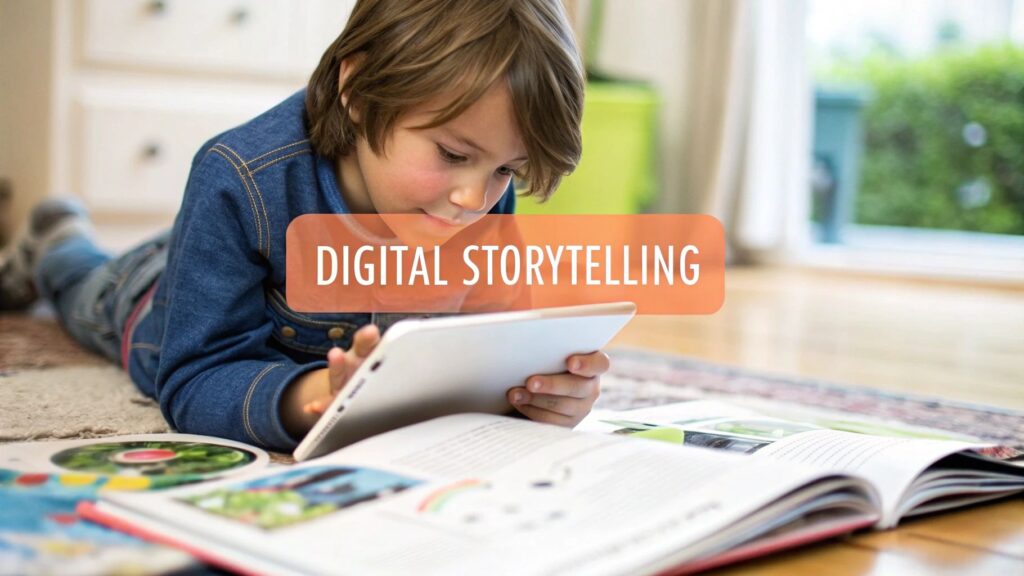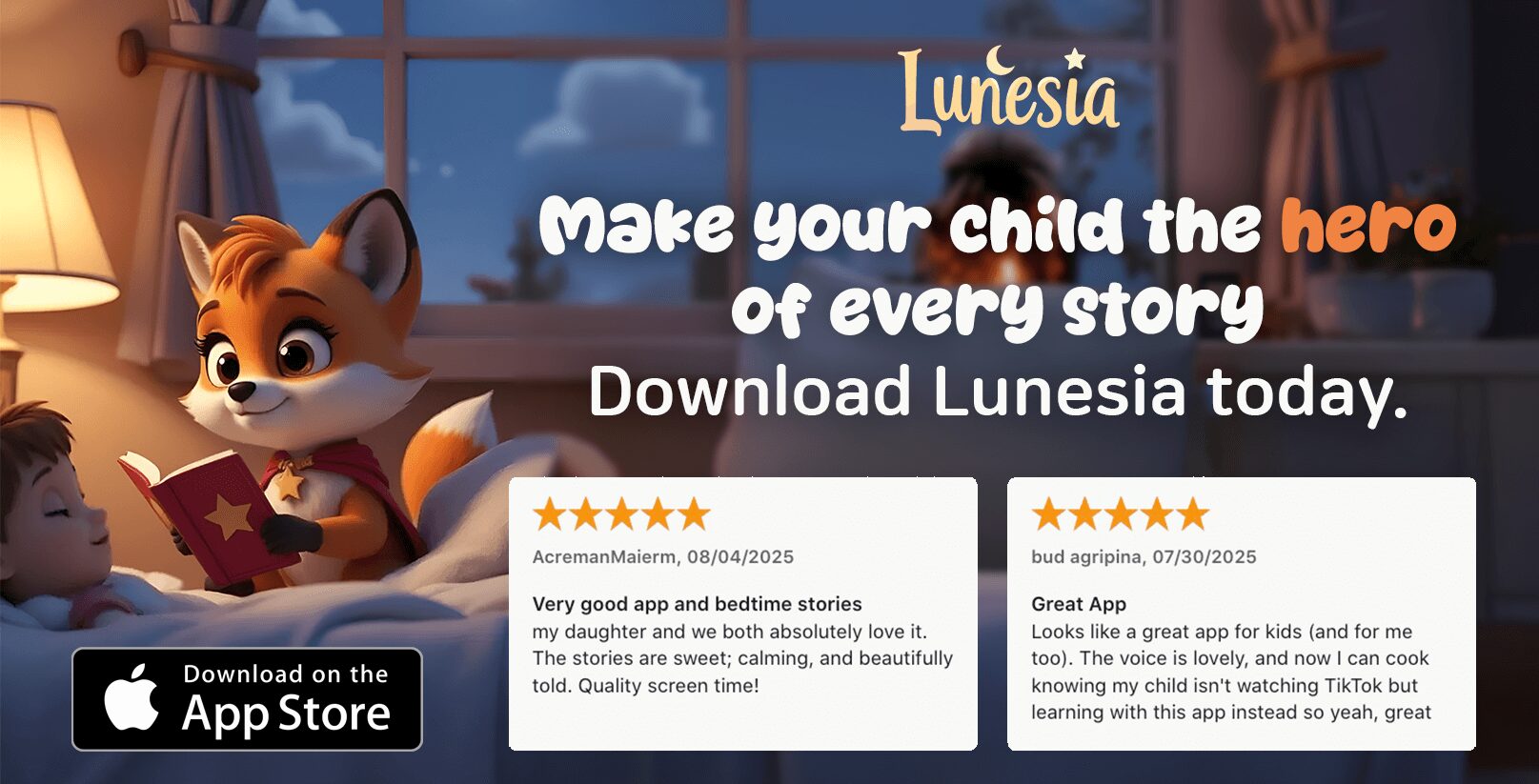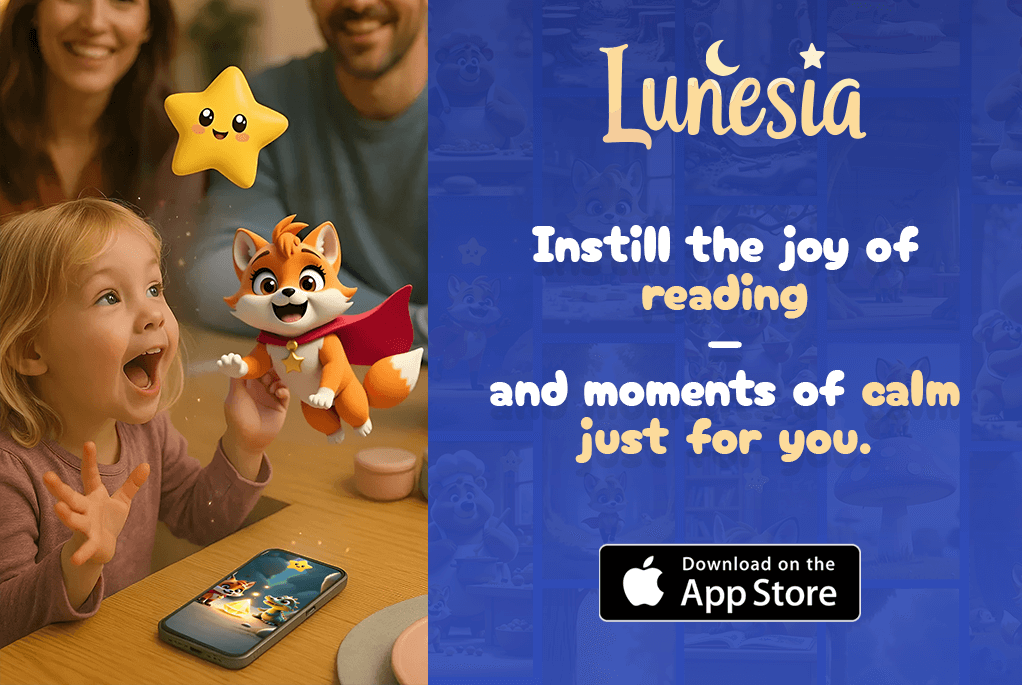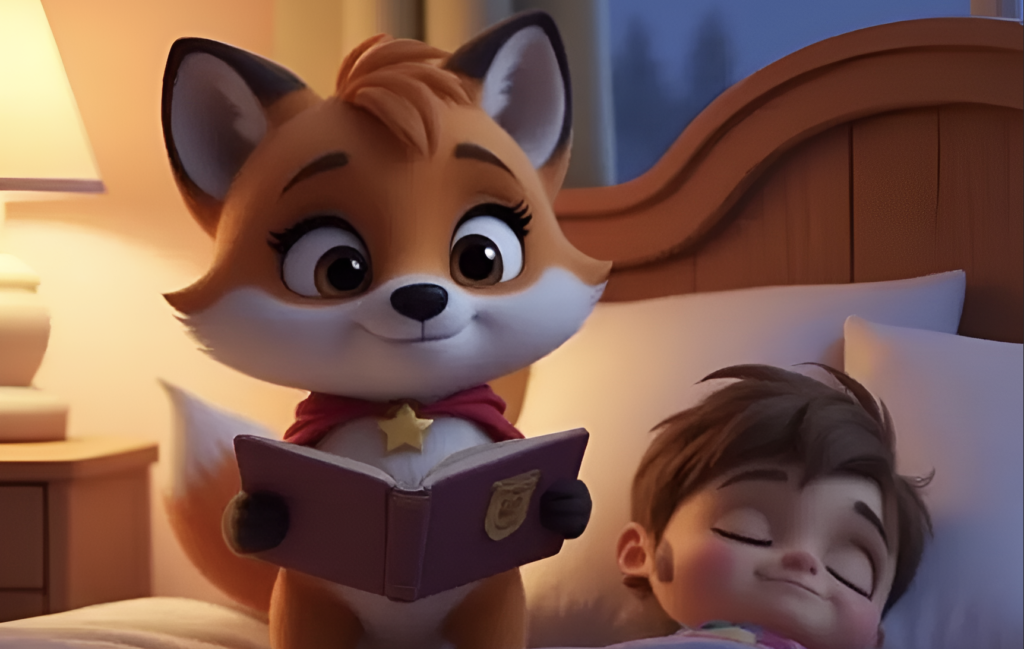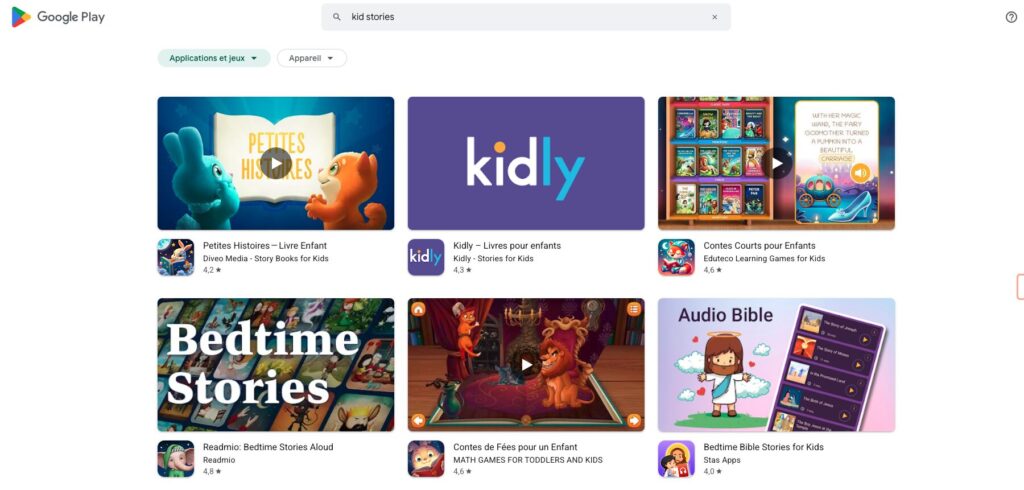Ever feel like the screen time battle is one you just can't win? Let’s try looking at it from a different angle. What if screen time could be less about distraction and more about development? Digital storytelling isn't just another app; it’s the evolution of the classic bedtime story, supercharged with gentle, thoughtful technology. Imagine a storybook that comes alive, inviting your child to step inside and become the hero of their very own adventure.
Beyond Cartoons: A New Kind of Screen Time
You know that glazed-over look your child gets from passively watching videos? What if their screen could spark curiosity, build confidence, and teach kindness instead? Digital storytelling transforms screen time from a mindless activity into a powerful tool for growth. It’s the difference between watching a character be brave and getting to be the brave one yourself.
At its heart, this is a method that blends timeless narratives with meaningful interactivity. Instead of just listening, your child actively shapes the journey. They make choices that influence the plot, helping characters solve problems and navigate big feelings. This active participation is what separates enriching digital stories from passive cartoons.
This infographic shows exactly how your child steps into the role of the hero, making decisions that guide the adventure from start to finish.
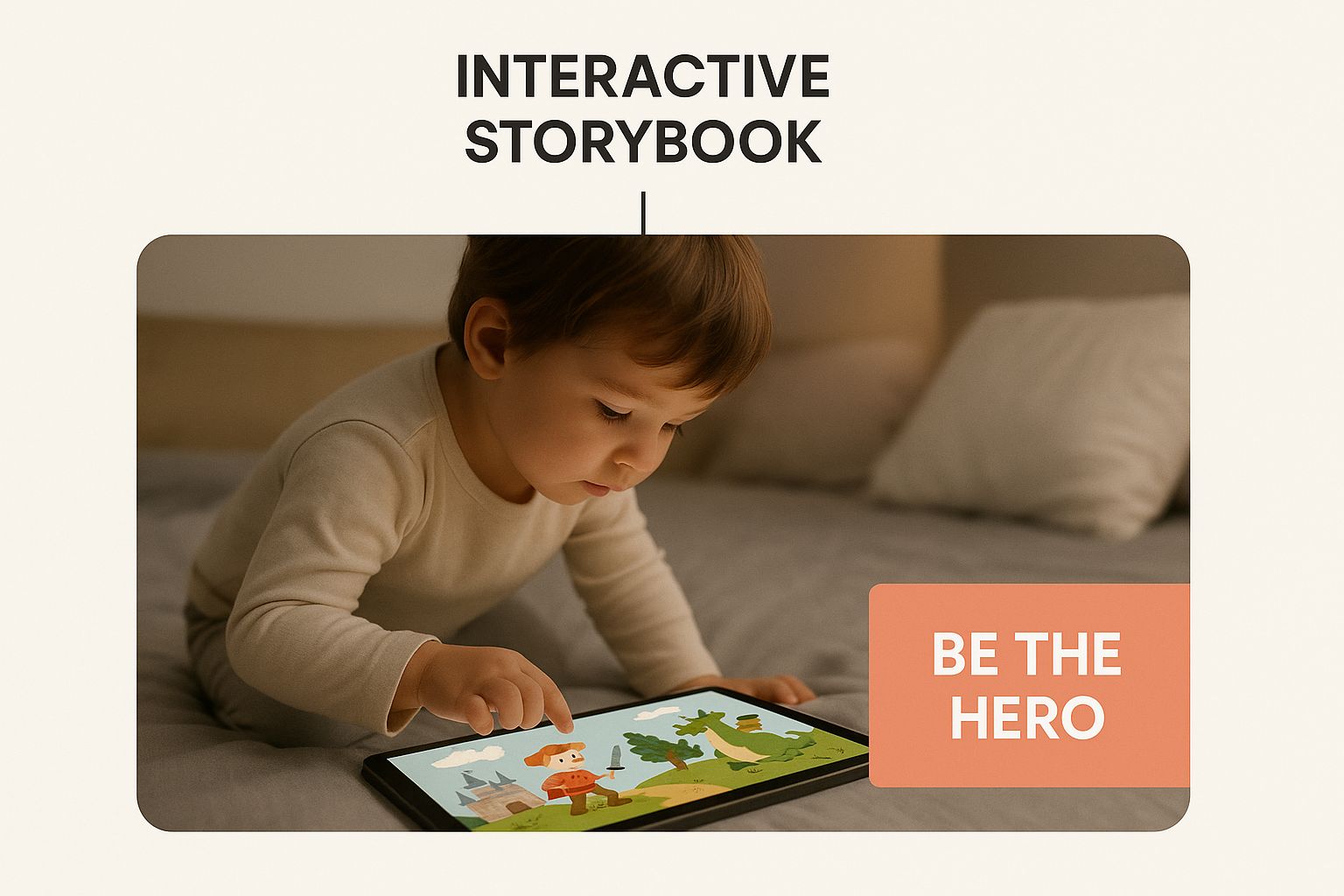
The image captures the core idea perfectly—it’s all about empowering your child to be the main character, not just a bystander.
Why Does This Matter for Your Child?
Think about those tough moments—the sudden tantrum in the grocery store, the fear of a monster under the bed, or the anxiety about a new sibling. How do you teach resilience in a way that actually sticks? Digital stories create a safe, imaginative playground for practicing these very skills.
When a child helps a lost squirrel find its way home in a Lunesia story, they aren't just tapping a screen. They're practicing empathy and problem-solving. This hands-on approach makes abstract values like courage and kindness feel real and achievable. It’s a concept central to the power of modern interactive storytelling.
This shift from passive consumption to active participation is crucial. Studies show that when children are actively engaged, their learning retention and cognitive development improve significantly. It turns screen time into a skill-building session you can feel good about.
And here’s the bonus for you: while your child is immersed in a safe, ad-free adventure, you get a moment. You can finish your coffee, reply to that email, or simply breathe, knowing they are engaged in something that genuinely supports their growth. It’s guilt-free time for you and a meaningful journey for them. As technology continues to evolve, it's fascinating to see the future potential and even consider the advancements in AI storytelling to see where these creative tools are headed.
The Three Pillars of Great Digital Stories
Ever wonder what separates a truly enriching digital story from just another flashy game? What makes one app feel genuinely good for your kid, while another feels like empty screen time? It really boils down to three core pillars that work together to create a powerful, positive experience.
When these elements are in place, digital storytelling becomes more than just entertainment—it becomes a tool for growth. It’s the difference between your child simply watching a hero be brave and getting to be the brave hero themselves.
Pillar 1: A Captivating Narrative
Before any bells or whistles, there has to be a good story. Just like the classic picture books you read at bedtime, a great digital story needs a heart. It needs compelling characters your child can root for and challenges they can actually understand.
But it’s not just about a fun plot. The best narratives are carefully crafted to teach something meaningful along the way. They might explore how to share with a friend, how to be brave when you’re scared of the dark, or how to show kindness to someone who is different. In Lunesia, every single story is built around a core value—like empathy, courage, or honesty—turning a simple adventure into a gentle life lesson.
A study on narrative impact revealed that people are 22 times more likely to remember a fact when it's wrapped in a story. This is exactly why a strong narrative is the foundation for making lessons stick.
Pillar 2: Meaningful Interactivity
This is where digital storytelling really shines. What happens when your child doesn't just listen to the story, but gets to influence it? They become an active participant, not a passive viewer. This is the pillar of meaningful interactivity.
It’s not about random tapping just to make an animation pop. It’s about making choices that matter. For example:
- Does the little knight share his lunch with the hungry dragon? This choice teaches generosity.
- Does the lost bunny ask for help or try to find its way home alone? This choice explores the value of community and courage.
In Lunesia, these decision points are the heart of the experience. We've designed each choice to empower children, helping them practice real-world social and emotional skills in a safe, fictional world. They get to see the direct consequences of their actions, learning cause and effect in a way that’s both fun and memorable.
Pillar 3: A Safe, Nurturing Environment
Finally, none of this matters if the environment isn’t completely safe. As a parent, you need to know that when you hand over the tablet, your child is protected. The third pillar is a 100% safe and nurturing space.
This means absolutely no ads, no external links, and no inappropriate content. A great digital story creates a walled garden where curiosity can flourish without risk. It’s a place where your child can explore, make mistakes, and learn without ever being exposed to pop-ups or confusing third-party content. This ad-free, secure design is a non-negotiable principle for us at Lunesia.
When these three pillars—a captivating story, meaningful choices, and a safe environment—come together, you get more than just an app. You get a guilt-free tool that supports your child's emotional growth and gives you a well-deserved moment of peace.
How Interactive Stories Build Emotional Intelligence
Ever dealt with a full-blown tantrum in the cereal aisle? Or tried to soothe a sudden fear of the dark? Those big, wobbly tears about starting school? We've all been there. These moments can feel overwhelming, for our little ones and for us.
But what if there was a way to practice navigating these big feelings before they happen in real-time? This is where the magic of digital storytelling comes in.
Think of interactive narratives as a safe playground for emotions. It’s like a flight simulator for feelings; your child gets to practice take-offs and landings in a controlled environment, so they're better prepared when things get turbulent. When they help a story character face a challenge, they're secretly learning how to manage their own real-world anxieties.
The power is in turning abstract advice like "be brave" or "be kind" into something they can actually do. A child can hear these phrases a hundred times, but an interactive story invites them to feel what it’s like to make a brave choice and see the amazing outcome for themselves.
From Big Feelings to Real Skills
Let's imagine a story about a little fox who is too shy to join the other animals' games. Instead of just being told that "it's good to make friends," your child gets to make a choice. Should they encourage the fox to say hello? Or maybe suggest building a sandcastle nearby to gently attract others?
This is exactly how Lunesia’s stories work. They put your child in the driver’s seat.
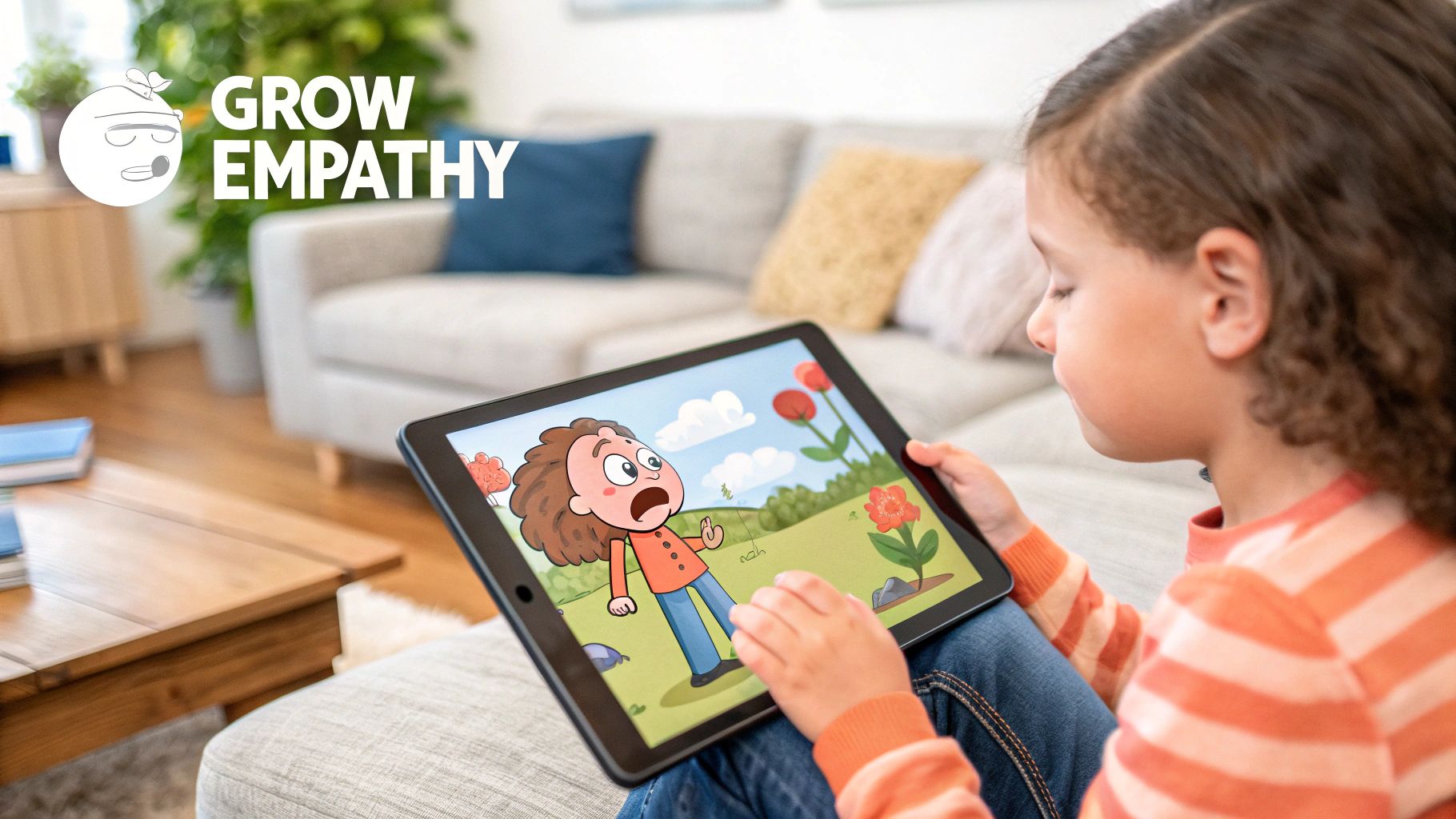
- Practicing Empathy: When your kid helps a sad gnome find his lost hat, they aren’t just completing a task. They’re stepping into the gnome's shoes, feeling his worry, and then experiencing the relief and joy of helping out. This builds a deep, instinctual understanding of what empathy feels like.
- Building Resilience: A story character might face a setback, like their kite getting stuck in a tree. Your child’s choice—to give up, ask for help, or try another idea—teaches them that challenges are just a part of life and that sticking with it pays off. They learn to bounce back from small failures in a world where it’s perfectly safe to do so.
- Developing Problem-Solving Skills: Is the bridge over the creek broken? Your child decides if the characters should build a new one, find another path, or work together to fix it. Each choice strengthens their critical thinking and shows them they are more than capable of finding solutions.
This hands-on approach is incredibly effective. Our brains are literally wired for narrative; in fact, research shows people remember information up to 22 times more when it’s wrapped in a story instead of presented as a list of facts. It’s this deep connection that makes the lessons stick.
A Safe Space for Emotional Rehearsal
Every parent worries about how to prepare their child for the world. How do we teach them to stand up for themselves, to be a good friend, or to handle disappointment gracefully? Interactive stories provide a brilliant answer.
They create a space for emotional rehearsal. Your child gets to experiment with different social strategies and emotional responses without any real-world risk. They see firsthand how their choices affect others, helping them develop a strong internal compass.
Lunesia’s ad-free, secure environment is a key part of this process. It’s a calm, protected world where the only focus is the story and the lesson it holds. There are no distracting pop-ups or external links to pull your child out of the moment. This focus is crucial for young minds just learning to regulate their thoughts and emotions. You can learn more about how emotional intelligence starts with stories in our detailed guide.
And here’s the wonderful bonus for you: while your child is deeply engaged in a meaningful adventure, building real-life skills, you get a few precious moments back. You can finally finish that cup of coffee, answer an email, or just take a moment to breathe. It’s guilt-free time because you know your child isn't just being entertained—they're learning, growing, and becoming a more resilient little person, one story at a time.
Turning Passive Viewing into Active Learning
We’ve all been there. You need just five uninterrupted minutes to make a call or start dinner, so you hand over the tablet. But what if that screen time—the very same time that often comes with a side of parental guilt—could be actively building your child’s brain?
What if it could be less like zoning out to a cartoon and more like a hands-on learning adventure?
This is the huge shift that choice-driven digital storytelling brings to the table. Think about it like this: anyone can watch a cooking show, passively taking in the information. But the real learning happens when you actually get your hands messy and help bake the cookies. That's the difference we’re talking about.
From Screen Zombie to Story Hero
Passive screen time often leads to that glazed-over, zombie-like state we all recognize. The content just happens to your child.
An interactive story, on the other hand, happens because of your child. It prompts them to think, to wonder, and to make a decision.
This isn’t just about tapping a screen to see a star twinkle. It’s about shaping an entire journey. When a character in a Lunesia story stands at a fork in the road, your child is the one who chooses which path to take. That one simple action transforms them from a spectator into the story's hero. They get to see the direct results of their decisions in a safe, imaginative world.
By placing the child in the driver's seat, interactive stories stimulate the prefrontal cortex—the part of the brain responsible for things like critical thinking and problem-solving. It’s a gentle workout for their developing mind.
This kind of active engagement does more than just entertain; it builds crucial cognitive muscles. They aren't just watching someone else solve a problem; they're the ones figuring it out, one choice at a time.
How Choices Build Smarter, Kinder Kids
So, how does this actually play out with your 4-year-old? Imagine a story where a little bear has lost its favorite toy. The app doesn’t just show the bear magically finding it. Instead, it might ask your child:
- Should we retrace our steps through the forest? This option encourages logical thinking and memory skills.
- Should we ask the wise old owl for help? This choice teaches the value of seeking guidance and working together.
- Should we make a new toy to cheer the bear up? This path nurtures creativity and empathy.
Each choice is a mini-lesson in disguise. Through these small but significant decisions, your child practices essential life skills without even realizing it. They are learning moral reasoning by seeing firsthand how kindness or perseverance leads to a happy ending. It's a world away from the one-way street of traditional cartoons, where the plot is fixed and your child has zero say.
The benefits here are huge. Children who engage with interactive stories show improved comprehension and are better at connecting what happens in the story to their own lives. They’re not just remembering a plot; they’re internalizing a process.
The Guilt-Free Bonus for You
Here’s the part that really matters for your day-to-day sanity. When your child is immersed in a Lunesia adventure, they are in a safe, ad-free world designed purely to help them grow. They are actively learning to be kind, brave, and resourceful. To see how this trend is evolving, you can explore resources from AI-powered interactive learning platforms that are pushing these new educational frontiers.
This means you get that much-needed time for yourself, minus the guilt. You can sip your coffee while it's still hot, knowing your child isn’t just being distracted—they're engaged in a powerful engine for cognitive and emotional development. It's the ultimate win-win: they are learning and growing, and you are getting a moment of peace, feeling confident and in control.
From Campfires to Tablets: The Journey of Storytelling
Have you ever stopped to think about how we went from telling stories around a crackling campfire to watching our kids craft their own adventures on a tablet? The journey is incredible, but the heart of storytelling hasn't changed one bit. The tools look different, sure, but the fundamental need to connect, teach, and inspire wonder is as human as ever.
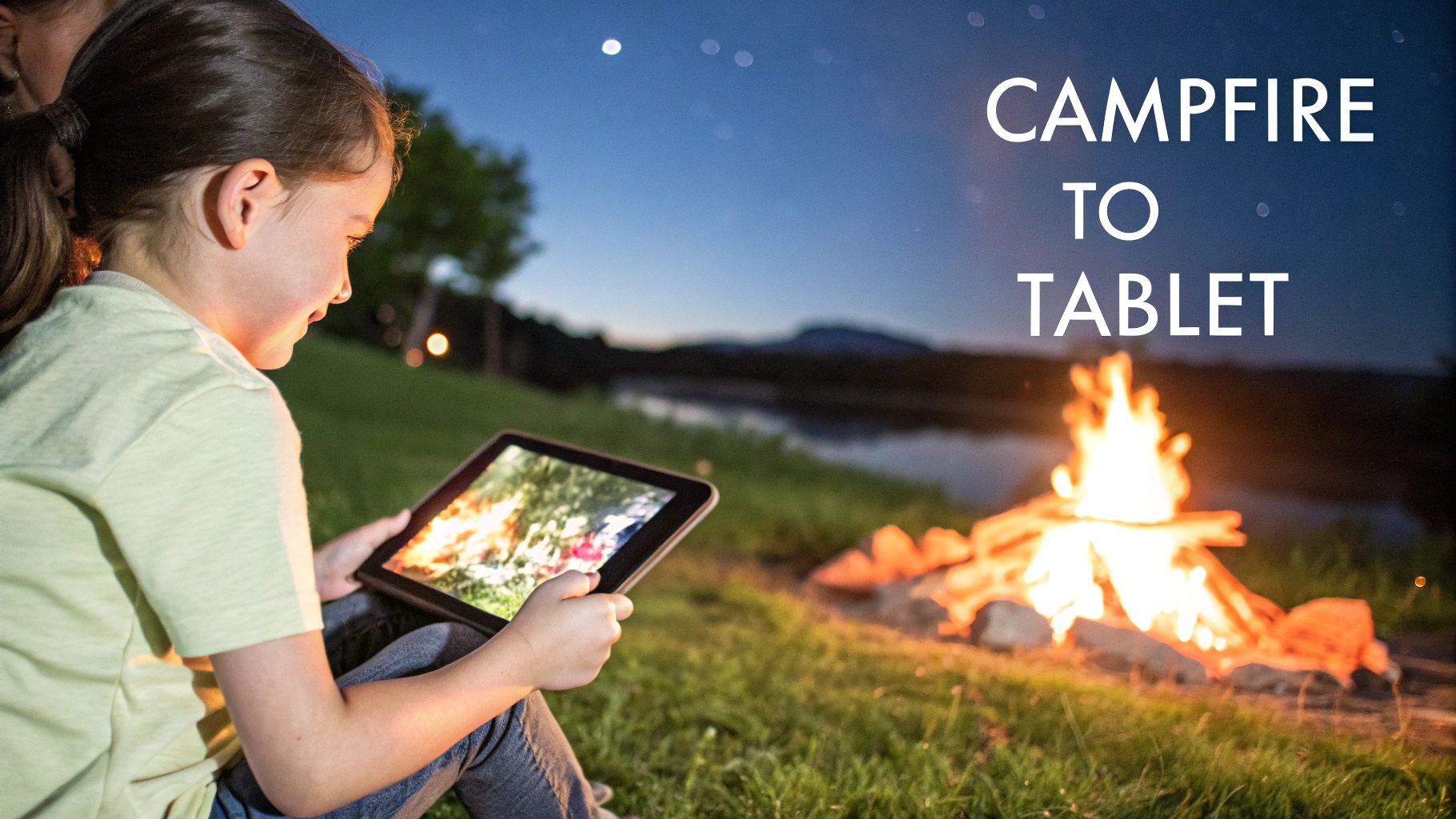
Long before screens lit up our faces, stories were the very glue that held societies together. They were the original instruction manuals for life, passing down values and helping children make sense of the world. Today, that ancient tradition is being reborn in a new and exciting form.
The Modern Story Circle
The leap to digital wasn't just about adding cool sounds or flashy animations. It was about inviting the listener to actually step inside the story. This shift from passively hearing a tale to actively participating in it really started gaining ground in the 1990s.
That's when pioneers like Dana Atchley and Joe Lambert helped define what we now call digital storytelling. They co-founded the Center for Digital Storytelling, launching workshops that gave everyday people the power to share their personal histories using multimedia. They showed everyone how technology could make stories more personal and profound. You can read more about their foundational work in the history of digital storytelling.
Honoring Tradition with New Tools
So, what does this brief history lesson have to do with your two-year-old’s epic tantrum or your seven-year-old’s newfound fear of the dark? Everything. It means that modern tools like Lunesia aren't just another app; they stand on the shoulders of a rich, time-honored craft. We’ve taken that timeless power of story—the part that builds empathy and courage—and woven it together with gentle, thoughtful technology.
It’s about honoring the past while embracing a future where stories can do more. A story on Lunesia isn’t just told; it’s experienced. Your child doesn’t just hear about kindness; they get to make a kind choice and see the beautiful outcome for themselves.
This is the evolution of the campfire. The glow now comes from a screen, but the magic is the same. While your child is safely immersed in an adventure, making choices that build their character, you can finally catch your breath. You’re not just handing them a distraction; you’re giving them a direct connection to one of humanity's oldest and most powerful traditions, reimagined for the 21st century.
Your Guide to Guilt-Free Screen Time
Let’s be honest for a second. That constant tug-of-war between needing a moment to yourself and feeling that pang of guilt when you hand over a screen? It's the ultimate parenting paradox. We all dream of a happy, engaged child and five minutes to just… breathe. But what if that screen time could be something you feel genuinely good about?
Imagine your child isn't just passively watching cartoons. What if they were on a magical quest, learning about kindness or figuring out how to help a friend, all while you get to finish your coffee while it's still hot? This isn't about finding a digital babysitter. It's about reframing that time as an enriching activity for them and a necessary recharge for you.
A Win-Win for the Whole Family
Parental burnout is real. In fact, studies show it impacts over 60% of parents. The mental load of worrying whether you're making the "right" choice with screen time can be just as draining as whatever you needed a break from in the first place. Finding sustainable ways to recharge isn’t a luxury—it’s essential for a happy, healthy home.
This is where a fresh perspective on screen time can be a game-changer. An interactive story from Lunesia isn't just a way to buy a few minutes. You're giving your child a powerful tool to practice emotional skills. While they’re busy deciding how to help a shy dragon make new friends, you get that much-needed space, knowing they are safe, engaged, and actually learning something valuable.
From Guilty Minutes to Growth Moments
Think about the last time you were at your wit's end. Maybe you were navigating a full-blown tantrum or just feeling completely touched-out and overwhelmed. Now, picture this instead:
- Instead of zoned-out cartoons, they’re on an adventure where they choose to be brave and help a lost star find its way home, actively building resilience.
- Instead of mindless app games, they’re solving a puzzle that teaches them about sharing, putting empathy into practice.
- Instead of ads and sketchy pop-ups, they are in a completely safe, protected world designed by child development experts to nurture their emotional intelligence.
This simple shift turns your moments of peace into your child's moments of growth. You're not just managing their behavior; you're actively fostering their character while reclaiming time for your own well-being.
It creates a positive feedback loop. When you feel more rested, you can be more patient and present. And when your child has a safe outlet to practice emotional regulation, they bring those skills into real life, leading to fewer meltdowns. It's a small change that helps create a more balanced and joyful family dynamic. For more ideas, our digital wellness kids' guide offers practical tips for building this balance at home.
So, the next time you need that break, you can hand over the tablet with confidence. You’re not taking a shortcut; you’re choosing a smarter, kinder path for both of you.
Got Questions About Digital Storytelling? We've Got Answers.
Jumping into the world of kids' apps and screen time can feel like you're trying to solve a puzzle in the dark. As a parent, you just want what's best for your little one, and that naturally comes with a lot of questions. We get it. Here are some of the most common things we hear from parents, answered in a way that’s clear and, hopefully, reassuring.
Is My Toddler Really Ready for This? What’s the Right Age?
You might be wondering if your two-year-old is old enough to be the hero of their own story. The answer is a resounding yes! Most interactive storytelling apps, including our own Lunesia, are designed specifically for children between 2 and 7 years old.
Everything from the simple choices they get to make to the gentle, age-appropriate themes is crafted with toddlers and early elementary schoolers in mind. It's the perfect entry point for them to explore, learn, and feel a sense of control over their own little adventures.
Is an Interactive Story Better Than a Real Book?
This is a question I hear all the time, and it’s a great one. The truth is, it’s not about one being "better" than the other—it's about them being wonderfully different. Nothing can ever replace the magic of cuddling up on the couch with a physical book. That’s a sacred part of childhood and bonding.
Think of interactive storytelling as a different kind of tool in your parenting toolkit. It’s a dynamic, hands-on experience that lets kids practice making decisions, thinking about others' feelings, and solving simple problems in a way a static page just can’t. A book might tell your child about what it means to be brave, but an interactive story lets them actually be brave.
How Can I Be Sure a Digital Storytelling App Is a Safe Place?
This is the most important question of all. Your child’s safety is everything. When you're vetting an app, you want to look for a few non-negotiable features that signal it's a protected space for them to play and learn.
Here’s your checklist:
- Zero ads. Their imaginative journey shouldn't be interrupted by someone trying to sell them something.
- A closed, secure platform. This means no sneaky external links that can lead them away from the app and into the wild, unfiltered internet.
- Content created with experts. The stories and activities should be designed by people who genuinely understand child development and know what little minds need to grow.
A truly safe app, like Lunesia, is built like a walled garden. It's a space where your child is free to wander, explore, and grow without you having to worry about what’s around the corner. Their well-being should always come first.
This method of learning through interactive stories is making waves in all sorts of areas. For example, it’s completely changing how history is taught, using things like interactive timelines to make the past feel immediate and real. And the best part? Modern tools allow experts to build these rich narratives without needing to be coding wizards. You can read more about its powerful impact on education to see just how far this medium can go.
Ready to make screen time a guilt-free, growth-filled adventure for your child (and a welcome moment of peace for you)?
Discover Lunesia today and watch your little one step into the role of the hero. Start your journey with our collection of interactive tales designed to build kindness, courage, and resilience.
